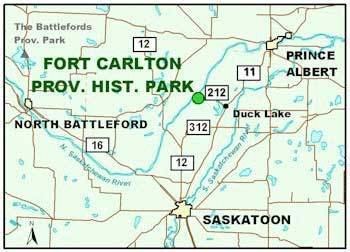Type Stockade Materials Wood Designated 1976 Year built 1810 | In use 1810-1885 | |
 | ||
Address 212 HWY, Duck Lake, SK S0K 0W0, Canada Similar Fort Pitt Provincial Park, Fort Battleford, Fort Walsh, Fort de la Corne, Cannington Manor Provincial | ||
Fort carlton rupert s land
Fort Carlton was a Hudson's Bay Company fur trade post from 1795 until 1885. It was rebuilt by the Saskatchewan government as a provincial historic park and can be visited today. It is about 65 kilometers north of Saskatoon.
Contents
- Fort carlton rupert s land
- Fort carlton saskatchewan
- History
- Three Locations
- Commercial
- Military
- Public
- References
Fort carlton saskatchewan
History
First called Carlton House, two previous posts were established in 1795 and 1805 respectively, before being abandoned for the third and permanent fort.
Three Locations
Commercial
As a Company post it primarily dealt in provisions, namely pemmican and buffalo robes although other furs were traded as well. Lawrence Clarke served as its last Chief Factor. It was a major base of operations for the Company's Saskatchewan District.
Situated on the Carlton Trail from the Red River Colony in present-day Manitoba to Fort Edmonton in what is now Alberta, Fort Carlton served as a hub for travellers. It was located along the North Saskatchewan River not far from Duck Lake, Saskatchewan.
Military
Treaty Six between the Canadian monarch and various Cree and Saulteaux First Nations was initially negotiated and signed near the Fort in 1876. Big Bear (Mistahimaskwa) had used the site in his initial negotiations for Treaty Six in about 1884, and finally, the following year he surrendered here after his engagement at Steele Narrows. The Prince Albert blockhouse was employed by the Royal Northwest Mounted Police on evacuating from Fort Carlton after the first fire.
The North-West Mounted Police leased the fort from the company in the 1880s, and it was their main base in the Saskatchewan Valley region. Following the Battle of Duck Lake it was abandoned by the police and Prince Albert Volunteers then briefly occupied by Gabriel Dumont's Métis forces, who later chose to withdraw to Batoche. During the 1885 conflict, the fort was destroyed by fire.
Public
Fort Carlton Provincial Park was opened in 1967. It features a partial reconstruction of the fort c. 1880, including four replica buildings of "Red River frame" construction.
The site was designated a National Historic Site of Canada in 1976.
